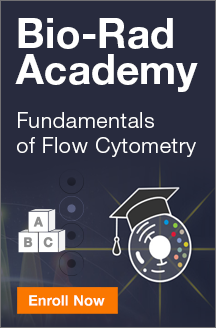-
US | en

Basic Design Rules
Before you build your panels it is critically important to have as clear an idea as possible of what is required to identify your population of interest. For example are you looking at one cell type or is it a subset, are you looking at an activation marker or a change in cell frequency, are the markers co-expressed or do you even know the expression pattern?
Fluorophore Separation
Ideally, when building multicolor panels, it is best to separate fluorophore excitation across lasers, and where possible, the emission across the detectors. This will minimize the amount of spillover and therefore compensation you will need to do. It will also reduce the effect that fluorescence spread will have on your data. However as you increase the number of fluorophores in your panel, this will not always be possible. Therefore other considerations need to be included in your design.
Antigen Density
The relative antigen density is of vital importance when choosing your fluorophores. As a general rule it is best to match bright fluorophores (e.g. PE) with low expressing markers and dimmer fluorophores (e.g. Pacific Blue) with highly expressed markers. Spread from a bright fluorophore will mask low level fluorescence in nearby channels. Careful choice of fluorophore will help with the resolution of your cell populations. Be careful however as fluorophore brightness can be a double edged sword. If you have a bright fluorophore and an abundant antigen this will create more spillover into adjacent channels, possibly masking any true signal into that channel from other markers.
Fluorophore Properties
Fluorophore properties are another thing to consider. You should be aware of cross-laser excitation, for example APC can be excited by the 405 nm laser as well as a 640 nm laser. In addition to the relative brightness of fluorophores the amount they spread is important. In general, brighter fluorophores will have greater spread and this can be more pronounced at longer wavelengths. In addition, although tandem dyes will give greater flexibility across lasers, allowing increased multiplexing capability, they should receive special care and attention. Take into account the possible donor fluorophore emission, e.g. for PE tandems there may be some emission at 578 nm. The acceptor excitation and emission should also be taken into consideration. Careful handling of tandem dyes, as they are sensitive to light and fixation, to avoid breakdown is recommended. In addition there can be lot-to-lot variation due to variation in the quantity of acceptor dyes on the donor molecule. Tandem dyes may not be suitable for intracellular staining so if your multiplex panel includes intracellular staining it may be best to use other fluorophores if possible.
Marker Expression Patterns
One common method of reducing the effect of spillover and spread is to carefully choose your fluorophores based upon the expression pattern of your antigens. This can be done by placing fluorophores with spillover onto mutually exclusive markers, e.g. CD3 and CD19. The effect of the spillover can be compensated fairly easily. In contrast for markers where there is co-expression e.g. cell subsets or unknown expression levels, fluorophores with minimal spillover should be chosen. This should also be the case for antigens where the expression pattern is continuous such as those seen in activation markers. Another way of minimizing the effect of spillover is to use the parent descendant rule. This is where the spillover does not matter as the marker is expressed anyway and the relative amount may not be important. An example of this could be spillover of CD4 fluorescence into the CD3 channel in T cells. As all the T cells will express CD3 anyway it does not matter.
Dump Channels
If you are not particularly interested in certain cell populations, you can create a dump channel. A dump channel, as the name suggests, removes all the unwanted sample by placing it in a channel that will be ignored. This is particularly useful when looking at rare cells, such as hematopoietic stem cells as any cells that are not required can be excluded by labeling all the cells with one fluorophore. Often the easiest way to do this is to use biotinylated primary antibodies and a streptavidin secondary of whatever color is being used for the dump channel. The viability stain can also be included in this channel for convenience as the negatives will be the live cells. A second way to remove unwanted cell populations is to do some careful gating post acquisition. If you know based on the forward or side scatter, or the expression of a marker, where your cells should appear you can exclude the cells. If you remove the cells you are not interested in, any unwanted binding or fluorescence spillover and spread caused by those cells will also be removed. This can be particularly useful when looking at myeloid cells. This should be performed with caution however to avoid removal of your cells of interest.
Pacific Blue is a trademark of Life Technologies Corporation
